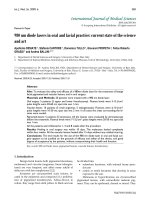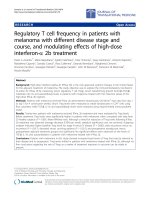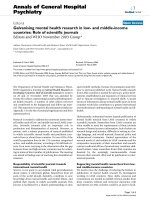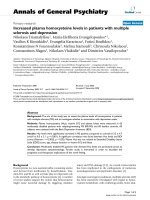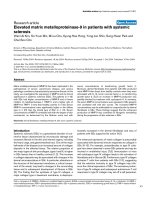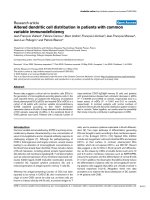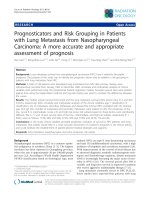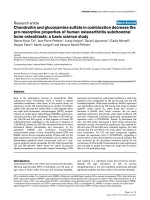Báo cáo y học: "Pre-hospital intubation by anaesthesiologists in patients with severe trauma: an audit of a Norwegian helicopter emergency medical service"
Bạn đang xem bản rút gọn của tài liệu. Xem và tải ngay bản đầy đủ của tài liệu tại đây (242.11 KB, 6 trang )
ORIGINAL RESEARCH Open Access
Pre-hospital intubation by anaesthesiologists in
patients with severe trauma: an audit of a
Norwegian helicopter emergency medical service
Stephen JM Sollid
1,2*
, Hans Morten Lossius
1,3
, Eldar Søreide
2,3
Abstract
Background: Anaesthesiologists are airway management experts, which is one of the reasons why they serve as
pre-hospital emergency physicians in many countries. However, limited data are available on the actual quality and
safety of anaesthesiologist-managed pre-hospital endotracheal intubation (ETI). To explore whether the general
indications for ETI are followed and what complications are recorded, we analysed the use of pre-hospital ETI in
severely traumatised patients treated by anaesthesiologists in a Norwegian helicopter emergency medical service
(HEMS).
Methods: A retrospective audit of prospectively registered data concerning patients with trauma as the primary
diagnosis and a National Committee on Aeronautics score of 4 - 7 during the period of 1994-2005 from a mixed
rural/urban Norwegian HEMS was performed.
Results: Among the 1255 cases identified, 238 successful pre-hospital ETIs out of 240 attempts were recorded
(99.2% success rate). Furthermore, we identified 47 patients for whom ETI was performed immediately upon arrival
to the emergency department (ED). This group represented 16% of all intubated patients. Of the ETIs performed in
the ED, 43 patients had an initial Glasgow Coma Score (GCS) < 9. Compared to patients who underwent ETI in the
ED, patients who underwent pre-hospital ETI had significantly lower median GCS (3 (3-6) vs. 6 (4-8)), lower revised
trauma scores (RTS) (3.8 (1.8-5.9) vs. 5.0 (4.1-6.0)), longer mean scene times (23 ± 13 vs. 11 ± 11 min) and longer
mean transport times (22 ± 16 vs. 13 ± 14 min). The audit also revealed that very few airway management
complications had been recorded.
Conclusions: We found a very high success rate of pre-hospital ETI and few recorded complications in the studied
anaesthesiologist-manned HEMS. However, a substantial number of trauma patients were intubated first on arrival
in the ED. This delay may represent a quality problem. Therefore, we believe that more studies are needed to
clarify the reasons for and possible clinical consequences of the delayed ETIs.
Background
Endotracheal intubation (ETI) is considered a key part
of pre-hospital advanced life support (ALS) in critically
ill and injured patients [1,2]. Recent studies [3-5] have,
however, documented high failure rates and life-threa-
tening complications with pre-hospital ETI. These high
failure and complication rates have been linked to sub-
optimal airway management training and experience of
the pre-hospital ALS provider [6]. To avoid these issues,
some pre-hospital emergency medical systems (EMS),
including the national helicopter emergency system
(HEMS) in Norway, have used anaesthesiologists as pre-
hospital emergency physicians for many decades [7-9].
However, anaesthesiologists active as pre-hospital emer-
gency physicians regard pre-hospital airway management
as challenging and recognise that such procedures likely
warrant special training beyond the experience of in-
hospital airway management [9].
Although there seems to be a general consensus on
when pre-hospital ETI should be performed [1,2,10,11],
limited data are available on the quality and safety of
anaesthesiologist-managed pre-hospital ETI in trauma
* Correspondence:
1
Department of Research and Development, Norwegian Air Ambulance
Foundation, Drøbak, Norway
Sollid et al. Scandinavian Journal of Trauma, Resuscitation and Emergency Medicine 2010, 18:30
/>© 2010 Sollid et al; licensee BioMed Central Ltd. This is an Open Access article distributed under the terms of the Creative Commons
Attribution License ( which permits unrestricted use, distribution, and reproduction in
any medium, provided the original work is properly cited.
patients [8,12,13]. Furthermore, the extent to which
indications for pre-hospital ETI are followed is not well
documented. Therefore, we decided to perform an audit
of pre-hospital ETI in seriously injured patients treated
in a typical [7,8] Norwegian HEMS. We focused on
whether trauma patients with an indication for pre-
hospital ETI actually received it (quality of airway man-
agement) and whether ETI attempts were successful and
without major complications (patient safety).
Materials and methods
Stavanger HEMS
The Stavanger HEMS is part of the national HEMS system
of Norway, and its primary areas of operation are the
mixed urban and rural districts of Rogaland County,
which consist of just over 400,000 inhabitants. The medi-
cal conditions treated by the HEMS are approximately 2/3
non-traumatic and 1/3 traumatic [8]. In 2006, the Stavan-
ger HEMS completed 1237 missions, of which 64% were
by helicopter and 36% by rapid response vehicle (RRV) [9].
The RRV is used as a back-up when the helicopter cannot
be used (due to weather conditions or other flight restric-
tions) or on missions close to the HEMS base. Both heli-
copter and RRV are operational day and night.
The HEMS crew consists of a pilot, a HEMS crew-
member and a physician. The minimum requirement
for HEMS physicians in Norway is 2 years of anaesthe-
siology as stated in a governmental report [9]. In addi-
tion flight operators require a flight operative initial
training and checking. Pre-hospital ETI is performed at
the discretion of the treating physician, and a variety of
anaesthetic drugs are available to facilitate ETI. Written
guidelines for pre-hospital ETI were available in the Sta-
vanger HEMS during the study period and adhered to
generally accepted indications for ETI outside the hospi-
tal [1,2,10,11]. Only minor adjustments were made to
these guidelines during the study period. There was no
specific difficult airway algorithm in the service in the
period other than the one available in the anaesthesiol-
ogy department under which it is organised. McCoy lar-
yngoscope [2] and trans-tracheal kits were the only back
up available in cases of difficult intubation until 2003
when the intubating laryngeal mask and the gum elastic
bougie [2] were included.
All missions are recorded in a pre-hospital patient
chart that includes core times (activation time, time of
arrival, time of departure and time patient care is
ended), vital parameters, patient data, applied interven-
tions, drugs used and a brief summary of the mission.
The charts also allow for scoring of the three compo-
nents of the revised trauma score (RTS) [14]: systolic
blood pressure, respiratory rate and Glasgow coma
score (GCS) [15].
Data collection
We retrospectively screened all records of patients treated
by the Stavanger HEMS between 1994 and 2005 and
extracted data from patients with severe trauma who
either died before arriving at the hospital or were admitted
to Stavanger University Hospital. We defined severe
trauma as a primary diagnosis of traumatic injury and a
National Committee on Aeronautics severity of injury or
illness index (NACA) [16] (Table 1) score of 4 or higher.
We recorded data from the pre-hospital patient charts,
as well as in-hospital data from the patient records. The
data included the type of airway device and drugs used to
facilitate ETI, complications and the use of monitoring,
including capnography. We anonymised the involved
HEMS physicians and recorded them as “anaesthesiologist
specialist” or “resident”. In cases in which the components
of RTS were not scored, we retrospectively scored them
based on data available from pre-hospital charts. RTS was
then calculated based on a weighted formula [14].
Ethics
The Regional Ethics Committee of Western Norway and
the Norwegian Social Science Data Service approved the
collection and recording of the study data.
Statistics
Data were recorded into a database designed with File
Maker (FileMaker Inc., Santa Clara, CA, USA). We used
Table 1 National Committee on Aeronautics severity of injury or illness index (NACA) [16]
Score Definition
0 No injury or disease
1 Injuries/diseases without any need for acute physician care
2 Injuries/diseases requiring examination and therapy by a physician but hospital admission is not indicated
3 Injuries/diseases without acute threat to life, but requiring hospital admission
4 Injuries/diseases which can possibly lead to deterioration of vital signs
5 Injuries/diseases with acute threat to life
6 Injuries/diseases transported after successful resuscitation of vital signs
7 Lethal injuries or diseases (with or without resuscitation attempts)
Sollid et al. Scandinavian Journal of Trauma, Resuscitation and Emergency Medicine 2010, 18:30
/>Page 2 of 6
independent sample t-tests to compare mean values, the
Mann-Whitney U Test to compare non-parametric
median values and 2 × 2 tables with the chi-squared test
for proportions. Mean values are presented with stan-
dard deviations and median values with the interquartile
range. Statistics were computed using PASW Statistics
18 (SPSS Inc., Chicago, IL, USA). A p-value < 0.05 was
considered statistically significant.
Results
A total of 1255 cases matched our inclusion criteria for
severe trauma. Table 2 shows the basic demographics.
When comparing missions carried out by helicopter or
RRV we found no significant difference in patient age,
sex, NACA score, RTS or GCS. Further, mean time to
scene and scene time were significantly shorter in RRV
missions compared to helicopter missions: 9 ± 8 vs.
17 ± 10 min (p < 0.001) and 10 ± 8 vs. 20 ± 13 min (p
= 0.001), respectively. There was no significant differ-
ence in transport times or the status of the treating phy-
sicians (anaesthesiologist specialist or resident).
Among the 1255 cases, 240 (19%) intubation attempts
were made pre-hospital with 238 recorded as successful,
yielding a 99.2% success rate. Forty patients in this
group died before arriving at the hospital and had a
median GCS of 3 (3 - 3) and RTS of 0.0 (0.0 - 0.0).
Additionally, 47 patients (16% of all intubated patients)
were intubated immediately upon arrival in the ED
(Table 3), all successfully. Among this group, 43 (92%)
patients had an initial GCS lower than 9, of whom eight
also had an initial RTS < 4 (Table 3). Patients who
underwent attempted pre-hospital ETI had a signifi-
cantly lower initial GCS, 3 (3 - 6) vs. 6 (4 - 8) (p <
0.001), and a lower initial RTS, 3.8 (1.8 - 5.9) vs. 5.0 (4.1
- 6.0) (p < 0.001), than those intubated in the ED. Sig-
nificantly more patients who underwent attempted pre-
hospital ETI also had both an RTS < 4 and a GCS of 3-
8 compared to those intubated in the ED (56 vs. 17%,
p < 0.001) (Table 3). Of the patients who underwent
pre-hospital ETI, 71 were intubated without any drugs
to facilitate ETI. Capnography use increased from 0% in
1998 to 79% in 2005 for successful pre-hospital ETIs
(Table 4). Three of the pre-hospital ETIs were recorded
with complications related to the procedure (Table 5).
There was no difference between the proportion of
patients with pre-hospital ETI cared for by residents
(13%) and consultants (88%) and the proportion of
patients with ETI in the ED cared for by residents (13%)
and consultants (87%) (p = 0.81). The individual physi-
cian performed between 1 and 11 (median 2) ETIs per
year of the recorded pre-hospital ETIs. The total num-
ber of ETIs and the numbers of patients with attempted
pre-hospital ETI and ETI in the ED varied from year to
year but with no apparent temporal trend (Table 4).
Pre-hospital intubation attempts were more often
made during helicopter missions than RRV missions
Table 2 Basic demographics of the 12-year helicopter emergency medical service (HEMS) dataset (percentage
calculated from total number of cases (n = 1255))
Patient sex (n = 1253) 930 male
(74.1%)
322 female
(25.7%)
Trauma category (n = 1255) 1097 blunt
(87.4%)
100 penetrating
(8.0%)
55 other (4.6%)
NACA category (n = 1255) 674 NACA 4
(53.7%)
361 NACA 5
(28.8%)
114 NACA 6
(9.1%)
106 NACA 7
(8.4%)
RTS category (n = 1198) 202 RTS < 4
(16.1%)
996 RTS > 4
(79.4%)
GCS category (n = 1194) 353 GCS 3-8
(28.1%)
841 GCS 9-15
(67.0%)
Type of response (n = 1255) 721 helicopter
(57.5%)
534 RRV
(42.5%)
Physician status (n = 1254) 205 resident
(16.3%)
1049 consultant
(83.6%)
GCS: Glasgow coma score
NACA: National Committee on Aeronautics severity of injury or illness index
RTS: Revised trauma score
HEMS: Helicopter emergency medical service
RRV: Rapid response vehicle
Sollid et al. Scandinavian Journal of Trauma, Resuscitation and Emergency Medicine 2010, 18:30
/>Page 3 of 6
(22 vs. 15%, p = 0.003). The mean scene time and trans-
port time were significantly longer in patients with pre-
hospital ETI compared to ETI in the ED: 23 ± 13 vs. 11
±11min(p<0.001)and22±16vs.13±14min(p=
0.001), respectively.
We found no difference in hospital days, ICU days or
ventilator days between the two groups, but significantly
more of the patients intubated in the ED were alive at
discharge compared to those with attempted pre-hospi-
tal ETI (78 vs. 55%, p = 0.003).
Discussion
In this audit of pre-hospital ETIs performed by anaes-
thesiologists in patients with severe trauma, we found a
high success rate (99.2%) and few recorded complica-
tions. However, a substantial proportion of patients with
an indication for pre-hospital ETI were not intubated
until arrival in the ED.
The pre-hospital ETI success rate in patients with
severe trauma was much better than those reported
from many non-physician-staffed EMS systems [4,5] and
similar to other physician-manned EMS systems [17,18].
The safety of pre-hospital ETIs should, therefore, not be
a major concern. However, the overall quality of pre-
hospital airway management is a different issue. We
defined and measured quality as whether those with an
indication for pre-hospital ETI actually received it. We
found that, for example, 43 patients with an initial GCS
Table 3 Distribution of patients according to National Committee on Aeronautics severity of injury or illness index
(NACA) score, revised trauma score (RTS), Glasgow coma score (GCS) and transport mode
NACA RTS GCS RTS < 4 and
GCS 3-8
RTS > 4 and
GCS 9-15
Transport mode
§
4 5 6 7 < 4 > 4 3-8 9-15 Air Ground
Attempted pre-hospital endotracheal
intubation (n = 240)
6 105 86 43
†
134 105 207 28 131* 28 116 98
Intubated in emergency
department (n = 47)
7 27 13 8 39 43 4 8 4 10 37
Not intubated (n = 968) 661 229 15 63
†
63 852 103 809 60** 808 408 497
* 40 dead before arriving at hospital, ** 58 dead before arriving at hospital.
†
Three patients in the “Attempted pre-hospital endotracheal intubation” and five in the “Not intubated” group were scored as NACA 7 but were first declared
dead after arrival at the hospital. These were not included in the “dead before arriving at hospital” group.
§
Patients not transported from the scene by the service were not included in the table.
Table 4 Annual distribution of patients with severe trauma
Year 1994 1995 1996 1997 1998 1999 2000 2001 2002 2003 2004 2005 Sum
Number of patients with severe trauma* 80 105 112 83 78 83 114 109 126 134 122 109 1255
Arrived at hospital alive 73 93 103 74 74 79 101 96 117 128 112 99 1149
Fraction of patients dead before hospital arrival (%) 9 11 8 11 5 5 11 12 7 5 8 9 9
Attempted pre-hospital ETI 20 29 19 19 13 18 21 17 29 14 27 14 240
ETI in the emergency department 03841655573047
Fraction of ED ETI among total ETI (%) 0 9.4 29.6 17.4 7.1 25.0 19.2 22.7 14.7 33.3 10.0 0 16.4
Capnography used in pre-hospital ETI 0000010134141134
Fraction of patients with pre-hospital ETI for which
capnography was used (%)
0 0 0 0 0 6 0 6 10 29 52 79 14
*Defined as National Committee on Aeronautics severity of injury or illness index (NACA) score 4-7.
ETI: Endotracheal intubation.
ED: Emergency department.
Table 5 Cases of failed or complicated pre-hospital endotracheal intubation (ETI)
Case ETI Successful Type of injury NACA CGS RTS Outcome
Oesophageal intubation Yes Blunt 6 3 3.51 Dead < 24 h
Bleeding No Blunt 6 3 2.78 Dead < 24 h
> 2 ETI attempts Yes Blunt 6 5 5.03 Alive at discharge
Emergency tracheotomy No Burns with facial laceration 6 3 0.58 Dead < 24 h
Naso-tracheal intubation Yes Blunt 7 3 0.00 Dead on scene
NACA: National Committee on Aeronautics Severity of Injury or Illness Index
GCS: Glasgow coma score, RTS: revised trauma score.
Sollid et al. Scandinavian Journal of Trauma, Resuscitation and Emergency Medicine 2010, 18:30
/>Page 4 of 6
on scene between 3-8 were intubated first on arrival in
the ED. We could not identify a particular reason for
this delay. In some of the pre-hospital patient charts, it
was noted that ETI had been postponed due to short
transport distance to the hospital. Indeed, the transport
times were shorter in patients intubated in the ED.
Additionally, their mean GCS and RTS were higher than
in the patients intubated pre-hospital. Hence, the com-
bination of short transport and a less severe injury may
be put forward as a partial explanation for the finding.
Although we based our interpretation of the results on
internationally accepted indications [1,2,10,11] for pre-
hospital ETI in patients with severe trauma, there are
several limitations to our audit. The data were collected
retrospectively, which always entails some limitations in
data quality. Future studies should collect data in a uni-
form manner to improve reliability and facilitate com-
parisons across systems and studies. The recently
published Utstein style template for reporting data from
pre-hospital advanced airway management [19] should
be useful for this purpose. Future studies should also
attempt to identify the reasons why HEMS physicians
abstain from pre-hospital ETI in patients with severe
trauma.
Our data were not adequately comprehensive to eluci-
date whether delayed ETI had any negative impact on
outcome. On the contrary, the higher survival to dis-
charge rate in the group first intubated in the ED could
indicate a detrimental effect of pre-hospital ETI. Patients
in the delayed ETI group were less severely injured
(higher GCS and RTS) and more likely to survive than
those intubated pre-hospital. Although this difference in
injury severity may explain our findings, we believe that
further studies are needed to clarify the clinical conse-
quences of delaying ETI until arrival in the ED. A recent
study from the Netherlands [20] also showed a failure to
adhere to guidelines for pre-hospital ETI in traumatic
braininjuryinalmosthalfofthestudiedpopulation.
Furthermore, the authors found a negative influence on
respiratory and metabolic parameters in patients not
intubated. Another recent study also indicated that
delaying ALS in critically injured patients until arrival in
the trauma centre worsens outcome [21].
One remaining question in this study is if any of the
successful pre-hospital intubations were unnecessary or
even harmful. We think this also must be considered a
quality problem, but our data did not allow such an
analysis. Still, 28 of the patients with pre-hospital ETI
had both a RTS > 4 and GCS 9-15, which puts them in
a category where the indication for ETI is unclear or at
least signifies that other factors, besides severity of
injury and GCS, must have influenced the decision to
intubate. In the 40 patients with pre-hospital ETI who
died before arriving at the hospital, we do not have data
to document cause of death, but must assume, based on
their low initial GCS and RTS, that death was related to
their injuries and not any potential harm following ETI.
Future studies on quality in pre-hospital ETI should
investigate and address these issues.
Our audit was limited to one HEMS system, and the
validity of our findings in other systems is, therefore,
uncertain. However, our finding that a large proportion
of patients with an indication for pre-hospital ETI did
not receive it deserves further attention.
Conclusions
This audit of pre-hospital ETI performed by anaesthe-
siologists in patients with severe trauma revealed that,
despite a high success rate and few recorded airway
management-related complications, a substantial num-
ber of patients with a pre-hospital indication for ETI
were intubated only after arrival in the ED. Our audit
did not fully uncover the reasons for this delay or deter-
mine whether the delay in ALS had detrimental conse-
quences for patients. We believe that our audit indicates
that future studies are needed and that a more standar-
dised reporting system for pre-hospital advanced airway
management would be useful for comparing airway
management in different HEMS services.
Acknowledgements
This project was supported through a Bjørn Lind research grant from the
Laerdal Foundation for Acute Medicine and a research fellowship from the
Norwegian Air Ambulance Foundation.
Author details
1
Department of Research and Development, Norwegian Air Ambulance
Foundation, Drøbak, Norway.
2
Department of Anaesthesiology and Intensive
Care, Stavanger University Hospital, Stavanger, Norway.
3
Department of
Surgical Sciences, Faculty of medicine, University of Bergen, Norway.
Authors’ contributions
SJMS designed the study, collected the data, performed the statistical
analysis and drafted the manuscript. HML and ES helped design the study
and draft and review the manuscript. All authors have read and approved
the final manuscript.
Competing interests
The authors declare that they have no competing interests.
Received: 25 April 2010 Accepted: 14 June 2010
Published: 14 June 2010
References
1. Advanced trauma life support for doctors ATLS: manuals for
coordinators and faculty. Chicago IL: American College of Surgeons, Eight
2008.
2. Smith CE, Walls RM, Lockey D, Kuhnigk H: Advanced Airway Management
and Use of Anesthetic Drugs. Prehospital Trauma Care New York: Marcel
DekkerSøreide E, Grande CM 2001, 203-253.
3. Timmermann A, Russo SG, Eich C, Roessler M, Braun U, Rosenblatt WH,
Quintel M: The out-of-hospital esophageal and endobronchial
intubations performed by emergency physicians. Anesth Analg 2007,
104:619-623.
4. Wang H, Cook LJ, Chang CC, Yealy D, Lave J: Outcomes after out-of-
hospital endotracheal intubation errors. Resuscitation 2009, 80:50-55.
Sollid et al. Scandinavian Journal of Trauma, Resuscitation and Emergency Medicine 2010, 18:30
/>Page 5 of 6

